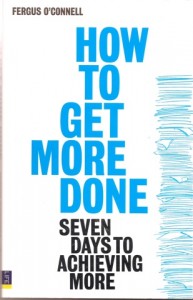The one-sentence summary
Do fewer things, only do the right things, and take less time doing them.
- Many of us feel we are struggling against an endless stream of tasks each day – both in our work and our personal lives. This book gives you everything you need to get things under control in one week.
- You need to embrace three new behaviours: not doing stuff; only doing the right stuff; and doing as little as possible when doing the right stuff.
- Don’t do the small things – do the ones that are big in relation to how important they are to your life.
- You need a system, but it must be flexible.
- It must include a list, a way of tracking appointments, a filing system, and a way of recording where your time goes.
- To work out how to re-programme yourself, you need to understand Dilts’s Neurological Levels of Change, which are (in order of importance):
Identity: who are you? This is your core sense of self and mission in life
Beliefs and values: why am I doing this? Can be both enabling and limiting
Capabilities: how do you deal with things? Skills and strategies that you use
Behaviour: specific actions and reactions in your daily environment
Environment: the external context in which you operate
WHAT’S GOOD ABOUT IT
- Figure out everything you have to do: pick a time period, list all your projects, add functional thing like meetings and reports, allow for interruptions, etc.
- Now work out how much time it will take to do it all.
- Write a dance card that shows what it all adds to – you may discover that it is twice the time you actually have. Now you can do something about it.
- There are lots of ways to say no to people: question why it needs to be done., deflect some requests, delegate more, negotiate, challenge demands for your time, make people aware of the consequences, etc.
- Deal with your guilt by stopping the sources and building up your resistance.
- Let stuff ‘go hang’
- When planning, say ‘I’ll have a look at it,’ work out what you have been asked to do and the sequence for getting it done, decide who will do what, allow for the unexpected, go back to the asker and say: ‘Here’s what I can do.’
WHAT YOU HAVE TO WATCH
- If you want to change your approach, you’ll have to knuckle down and fill out the whole system to get a result.

